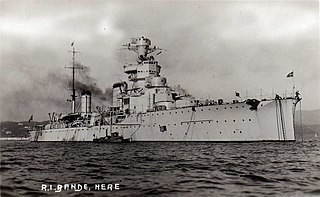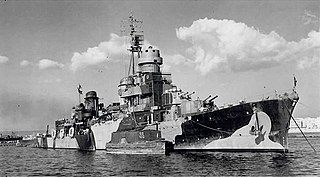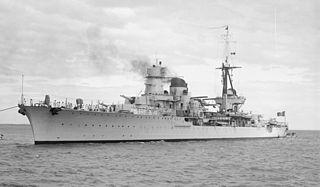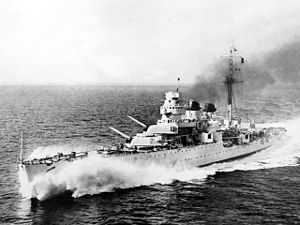
The Battle of Cape Matapan was a naval battle during the Second World War between the Allies, represented by the navies of the United Kingdom and Australia, and the Royal Italian navy, from 27 to 29 March 1941. Cape Matapan is on the south-western coast of the Peloponnesian Peninsula of Greece.

The Trento class was a group of two heavy cruisers built for the Italian Regia Marina in the late 1920s, the first such vessels built for the Italian fleet. The two ships in the class—Trento and Trieste, were named after the redeemed cities of Trento and Trieste taken from the Austro-Hungarian empire after the victory in World War I. The ships were very lightly armored, with only a 70 mm (2.8 in) thick armored belt, though they possessed a high speed and heavy armament of eight 203 mm (8.0 in) guns. Nominally built under the restrictions of the Washington Naval Treaty, the two cruisers nevertheless exceeded the displacement limits imposed by the treaty.

The Regia Marina was the navy of the Kingdom of Italy from 1861 to 1946. In 1946, with the birth of the Italian Republic, the Regia Marina changed its name to Marina Militare.

Giovanni delle Bande Nere was an Italian light cruiser of the Giussano class, which served in the Regia Marina during World War II. She was named after the eponymous 16th-century condottiero and member of the Medici family. Her keel was laid down in 1928 at Cantieri Navali di Castellammare di Stabia, Castellammare di Stabia; she was launched on 27 April 1930, and her construction was completed in 1931. Unlike her three sisters, the finish and workmanship on the vessel were not rated highly. She was sunk on 1 April 1942 by the British submarine HMS Urge.

The Condottieri class was a sequence of five different light cruiser classes of the Regia Marina, although these classes show a clear line of evolution. They were built before World War II to gain predominance in the Mediterranean Sea. The ships were named after condottieri of Italian history.

Bartolomeo Colleoni was an Italian Giussano-class light cruiser, that served in the Regia Marina during World War II. It was named after Bartolomeo Colleoni, an Italian military leader of the 15th century.

Trieste was the second of two Trento-class heavy cruisers built for the Italian Regia Marina. The ship was laid down in June 1925, was launched in October 1926, and was commissioned in December 1928. Trieste was very lightly armored, with only a 70 mm (2.8 in) thick armored belt, though she possessed a high speed and heavy armament of eight 203 mm (8.0 in) guns. Though nominally built under the restrictions of the Washington Naval Treaty, the two cruisers significantly exceeded the displacement limits imposed by the treaty. The ship spent the 1930s conducting training cruises in the Mediterranean Sea, participating in naval reviews held for foreign dignitaries, and serving as the flagship of the Cruiser Division. She also helped transport Italian volunteer troops that had been sent to Spain to fight in the Spanish Civil War return to Italy in 1938.

Trento was the first of two Trento-class cruisers; they were the first heavy cruisers built for the Italian Regia Marina. The ship was laid down in February 1925, launched in October 1927, and was commissioned in April 1929. Trento was very lightly armored, with only a 70 mm (2.8 in) thick armored belt, though she possessed a high speed and heavy armament of eight 203 mm (8.0 in) guns. Though nominally built under the restrictions of the Washington Naval Treaty, the two cruisers significantly exceeded the displacement limits imposed by the treaty.

The Capitani Romani-class was a class of light cruisers acting as flotilla leaders for the Regia Marina. They were built to outrun and outgun the large new French destroyers of the Le Fantasque and Mogador classes. Twelve hulls were ordered in late 1939, but only four were completed, just three of these before the Italian armistice in 1943. The ships were named after prominent Ancient Romans.

Alberto da Giussano was an Italian Giussano-class cruiser, which served in the Regia Marina during World War II. She was launched on 27 April 1930.

Luigi Cadorna was an Italian Condottieri-class light cruiser, which served in the Regia Marina during World War II; named after Italian Field Marshal Luigi Cadorna who was commander in Chief of the Italian Army during World War I.

Raimondo Montecuccoli was a Condottieri-class light cruiser serving with the Italian Regia Marina during World War II. She survived the war and served in the post-war Marina Militare until 1964.

Muzio Attendolo was a Condottieri-class light cruiser of the Italian Regia Marina which fought in World War II. She was sunk in Naples by bombers of the United States Army Air Forces (USAAF) on 4 December 1942. Although salvaged after the war, she was damaged beyond repair and was scrapped.

Emanuele Filiberto Duca d'Aosta was an Italian light cruiser of the fourth group of the Condottieri-class, that served in the Regia Marina during World War II. She survived the war, but was ceded as war reparation to the Soviet Navy in 1949. She was finally renamed Kerch and served in the Black Sea Fleet until the 1960s.

Giuseppe Garibaldi was an Italian Duca degli Abruzzi-class light cruiser, that served in the Regia Marina during World War II. After the war she was retained by the Marina Militare and upgraded. She was built by CRDA, in Stabilimento Tecnico Triestino shipyard Trieste and named after the Italian general Giuseppe Garibaldi.

The Etna class were two cruisers originally ordered in Italy for the Thai Navy in 1938 and subsequently requisitioned for service by the Italian Navy on the outbreak of World War II, neither ship was completed and the damaged hulls were scrapped after the war.

The Battle of the Strait of Otranto was a minor naval skirmish on 12 November 1940 during the Battle of the Mediterranean in World War II. It took place in the Strait of Otranto in the Adriatic Sea, between Great Britain and Italy.

Varese was a Giuseppe Garibaldi-class armored cruiser built for the Royal Italian Navy in the 1890s. The ship made several deployments to the Eastern Mediterranean and the Levant before the start of the Italo-Turkish War of 1911–12. She supported ground forces in the occupations of Tripoli and Homs in Libya. Varese may have bombarded Beirut and did bombard the defenses of the Dardanelles during the war. She also provided naval gunfire support for the Italian Army in Libya. During World War I, the ship's activities were limited by the threat of Austro-Hungarian submarines and Varese became a training ship in 1920. She was struck from the naval register in 1923 and subsequently scrapped.

Luigi Biancheri was an Italian admiral during World War II.



















